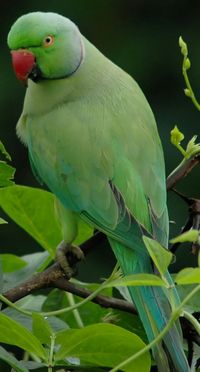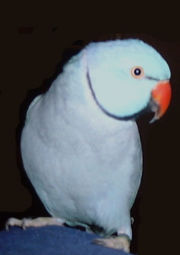Rose-ringed Parakeet
Conservation status Least concern |

|
|
Scientific classification |
| Kingdom: |
Animalia
|
| Phylum: |
Chordata
|
| Class: |
Aves
|
| Order: |
Psittaciformes
|
| Family: |
Psittacidae
|
| Genus: |
Psittacula
|
| Species: |
P. krameri
|
|
|
Binomial name |
Psittacula krameri
(Scopoli,
1769) |
The Rose-ringed Parakeet (Psittacula krameri),
also known as the Ring-necked Parakeet, is a
gregarious tropical
parakeet species that is popular as a pet. Its scientific
name commemorates the Austrian naturalist Wilhelm Heinrich
Kramer.
This
non-migrating species is one of few parrot species that
have successfully adapted to living in 'disturbed habitats',
and in that way withstood the onslaught of urbanisation and
deforestation. In the wild, this is a noisy species with an
unmistakable squawking call. Rose-ringed Parakeets are
sexually dimorphic, and adult males sport black markings
under their beaks and a dark band of colors around their
necks.
Phylogeny and distribution
Four
subspecies are recognized, though they do not differ
much:
-
- African Rose-ringed Parakeet (P.
krameri krameri): West Africa in Guinea, Senegal
and southern Mauretania, east to Western Uganda and
Southern Sudan.
- Abyssinian Rose-ringed Parakeet (P.
krameri parvirostris): Northwest
Somalia, west across northern Ethiopia to Sennar
district, Sudan.
-
- Indian Rose-ringed Parakeet (P.
krameri manillensis): Originated from the
southern
Indian subcontinent; introduced populations
worldwide.
- Neumann's Rose-ringed Parakeet (P.
krameri borealis): east
Pakistan, northern India and Nepal to central Burma;
introduced populations worldwide in
localities.
A
phylogenetic analysis using DNA (see Psittacula) showed that
the Mauritius Parakeet (Psittacula echo) is closely related
to this species, and probably needs to be placed between the
African and Asian subspecies. Consequently, this species is
paraphyletic.
Diet
In the wild, Rose-ringed Parakeets usually feed on buds,
fruits, vegetables, nuts, berries and seeds.
Size
The Rose-ringed Parakeet is on average 40 cm (16 inches) long including the tail feathers. Its average
single wing length is about 15–17.5 cm (6-7 inches). The
tail accounts for a large portion of the length. The Indian
Rose-ringed Parakeet, African Rose-ringed Parakeet,
Abyssinian Rose-ringed Parakeet and Neumann's Rose-ringed
Parakeet measure 42 cm, 40 cm, 40 cm and 43 cm long,
respectively.
Feral Rose-ringed Parakeets
The Rose-ringed Parakeet has established feral
populations in India and a number of European cities. There
are also apparently stable populations in the USA in Florida
and California. There also a small but sizeable population
of Rose-ringed Parakeets in Tehran, Iran mostly concentrated in the northern parts of city.
The Indian subspecies established itself in Britain
during the mid to late 20th Century from introduced and
escaped birds. There are two main population centres: the
largest is based around south London, Surrey and Berkshire,
and by 2005 consisted of many thousands of birds. A smaller
population occurs around Margate and Ramsgate, Kent.
Elsewhere in Britain, smaller feral populations have
established from time to time (e.g., at Studland, Dorset).
However, in some parts of South Asia - from where the
Rose-ringed Parakeets originated, populations of these birds
are decreasing due to trapping for the pet trade. Despite
some people's attempts to revive their population by freeing
these birds from local markets, the Rose-ringed Parakeet's
population has dropped drastically in many areas of the
Indian subcontinent.
Rose-ringed Parakeets as pets

A blue Rose ring
These birds where first bred by the people of India at
least 3,000 years ago, and color mutations of Rose-ringed
parakeets were also bred. The royals prized them as pets and
for their ability to speak. It was a popular status symbol
in Indian culture to have a Rose-ringed parakeet. They were
the first parrots brought to Europe and the Greeks were the
first Europeans to breed them.
Socrates is reported to have praised its beauty and
ability to speak.
The Romans then bred them for pets, and their beauty in
their aviaries. In the 1920's
aviculturists the popularity of the breed began to
increase greatly. Now widely available in the pet trade,
Rose-ringed Parakeets continue to gain popularity. Hand-fed
Rose-ringed Parakeets are regarded as excellent pets if
provided with daily attention, though even parent-raised
Rose-ringed Parakeets make good pets when provided with
regular handling and attention. They are generally family
birds and are less likely to bond to only one person. With
adequate attention, handling, and love, a Rose-ringed
Parakeet can quickly become a beloved companion.
Rose-ringed Parakeets are known to be hardy birds
requiring less interaction than most other
parakeets of their size. This makes them ideal for a
bird owner who cannot spend as much time with his/her bird
as other species need. Rose-ringed Parakeets can cope with
as little as half an hour of interaction a day. However,
they can become untame if not provided with daily
interaction, especially during their early months.
They require a relatively tall
cage because of their long tails. A Rose-ringed Parakeet
who will be spending most of his/her day inside the cage
should be kept in a cage about 60 cm (24") wide x 45 cm
(18") deep x 90 cm (36") high, though the larger the better,
and the bar spacing should be between 1.25 cm (1/2 inch) and
1.875 cm (3/4 inch). Rose-ringed Parakeets are avid chewers
and climbers and should therefore be provided with chewing
toys in their cages. The cages should be in a place out of
direct sunlight and free of drafts. A pet or captive
Rose-ringed Parakeet should be kept in a
bird-safe environment.
Captive Rose-ringed Parakeets should be fed a
nutritionally balanced diet of pellets and seeds, and the
appreciated fruit, vegetable or nut treat should also be
offered often. They should always have access to fresh water
in their cages.
The Rose-ringed Parakeet is considered one of the best
talking parakeets and can learn a vocabulary of up to 250
words. Now these birds come in many mutations, including the
common green, blue, grey and lutino among many other colors.
References
- BirdLife International (2004).
Psittacula krameri. 2006 IUCN Red List of
Threatened Species. IUCN 2006. Retrieved on 05 May 2006. Database entry
includes justification for why this species is of least
concern
External links




